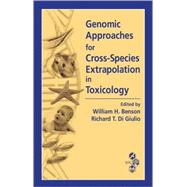
Note: Supplemental materials are not guaranteed with Rental or Used book purchases.
Purchase Benefits
Looking to rent a book? Rent Genomic Approaches for Cross-Species Extrapolation in Toxicology [ISBN: 9781420043341] for the semester, quarter, and short term or search our site for other textbooks by Benson; William H.. Renting a textbook can save you up to 90% from the cost of buying.
| List of Figures | xiii | ||||
| List of Tables | xv | ||||
| The Editors | xvii | ||||
| Contributors | xix | ||||
| Preface | xxi | ||||
| Acknowledgments | xxiii | ||||
| Chapter 1 "Omics" Approaches in the Context of Environmental Toxicology | 1 | ||||
|
|||||
|
1 | ||||
|
1 | ||||
|
4 | ||||
|
6 | ||||
|
6 | ||||
|
8 | ||||
|
9 | ||||
|
9 | ||||
|
10 | ||||
|
10 | ||||
|
14 | ||||
|
14 | ||||
|
16 | ||||
|
18 | ||||
|
20 | ||||
|
21 | ||||
|
21 | ||||
|
25 | ||||
|
25 | ||||
|
26 | ||||
| Chapter 2 Selection of Surrogate Animal Species for Comparative Toxicogenomics | 33 | ||||
|
|||||
|
33 | ||||
|
34 | ||||
|
36 | ||||
|
37 | ||||
|
39 | ||||
|
40 | ||||
|
40 | ||||
|
46 | ||||
|
47 | ||||
|
47 | ||||
|
48 | ||||
|
49 | ||||
|
49 | ||||
|
50 | ||||
|
52 | ||||
|
52 | ||||
|
53 | ||||
|
55 | ||||
|
56 | ||||
|
57 | ||||
|
58 | ||||
|
59 | ||||
|
60 | ||||
|
61 | ||||
|
62 | ||||
|
63 | ||||
|
64 | ||||
|
65 | ||||
|
70 | ||||
|
71 | ||||
|
73 | ||||
| Chapter 3 Species Differences in Response to Toxic Substances: Shared Pathways of Toxicity — Value and Limitations of Omics Technologies to Elucidate Mechanism or Mode of Action | 77 | ||||
|
|||||
|
78 | ||||
|
84 | ||||
|
85 | ||||
|
86 | ||||
|
87 | ||||
|
88 | ||||
|
89 | ||||
|
90 | ||||
|
92 | ||||
|
92 | ||||
|
93 | ||||
|
93 | ||||
|
93 | ||||
|
94 | ||||
|
95 | ||||
|
95 | ||||
|
95 | ||||
|
96 | ||||
|
97 | ||||
|
97 | ||||
|
98 | ||||
|
100 | ||||
| Chapter 4 Bioinformatic Approaches and Computational Models for Data Integration and Cross-Species Extrapolation in the Postgenomic Era | 103 | ||||
|
|||||
|
103 | ||||
|
106 | ||||
|
108 | ||||
|
109 | ||||
|
110 | ||||
|
110 | ||||
|
110 | ||||
|
111 | ||||
|
112 | ||||
|
112 | ||||
|
112 | ||||
|
114 | ||||
|
115 | ||||
|
116 | ||||
|
117 | ||||
|
117 | ||||
|
120 | ||||
|
121 | ||||
|
122 | ||||
|
122 | ||||
|
124 | ||||
|
126 | ||||
|
127 | ||||
|
128 | ||||
|
129 | ||||
|
130 | ||||
|
130 | ||||
|
133 | ||||
|
134 | ||||
|
136 | ||||
|
138 | ||||
|
141 | ||||
|
141 | ||||
|
142 | ||||
| Chapter 5 The Extension of Molecular and Computational Information to Risk Assessment and Regulatory Decision Making | 151 | ||||
|
|||||
|
151 | ||||
|
152 | ||||
|
154 | ||||
|
155 | ||||
|
157 | ||||
|
160 | ||||
|
160 | ||||
|
160 | ||||
|
162 | ||||
|
162 | ||||
|
162 | ||||
|
162 | ||||
|
163 | ||||
|
164 | ||||
|
166 | ||||
|
168 | ||||
|
168 | ||||
|
168 | ||||
|
168 | ||||
|
170 | ||||
|
172 | ||||
|
172 | ||||
|
173 | ||||
|
174 | ||||
|
175 | ||||
|
176 | ||||
|
178 | ||||
|
178 | ||||
| Index | 181 |
The New copy of this book will include any supplemental materials advertised. Please check the title of the book to determine if it should include any access cards, study guides, lab manuals, CDs, etc.
The Used, Rental and eBook copies of this book are not guaranteed to include any supplemental materials. Typically, only the book itself is included. This is true even if the title states it includes any access cards, study guides, lab manuals, CDs, etc.